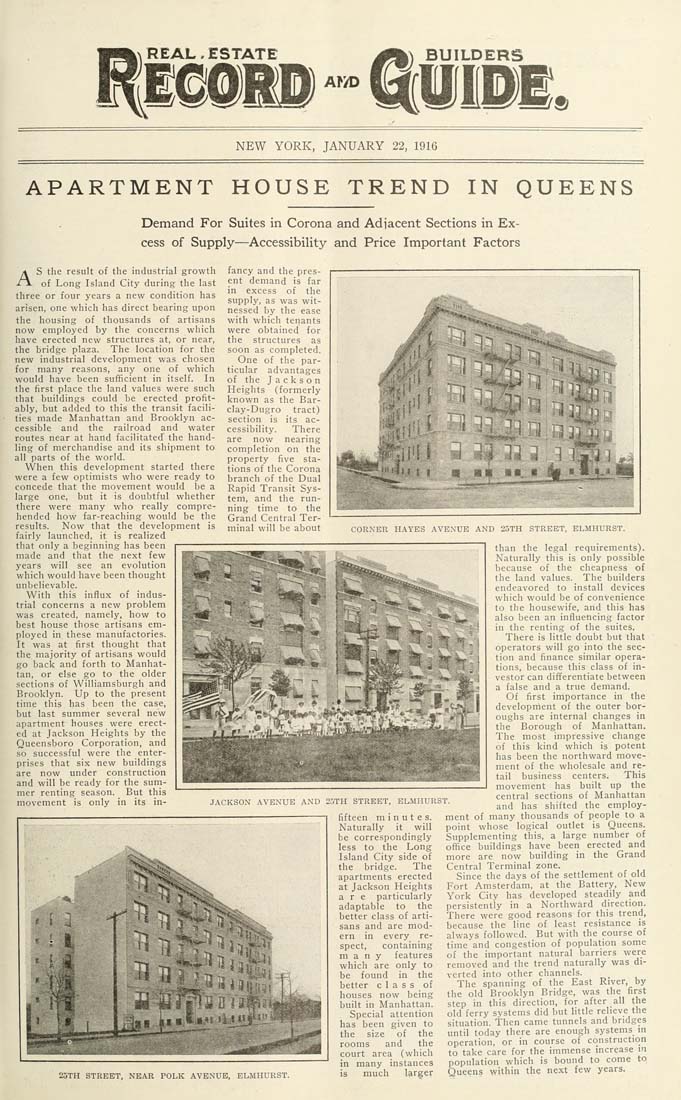Columbia University Libraries Digital Collections: The Real Estate Record
Use your browser's Print function to print these pages.
Real estate record and builders' guide: [v. 97, no. 2497: Articles]: January 22, 1916

Text version:
Please note: this text may be incomplete. For more information about this OCR, view About OCR text.
REAL. ESTATE Afyo W) BUILDERS NEW YORK, JANUARY 22, 1916 APARTMENT HOUSE TREND IN QUEENS Demand For Suites in Corona and Adjacent Sections in Ex¬ cess of Supply—Accessibility and Price Important Factors As the result of the industrial growth of Long Island City during the last three or four years a new condition has arisen, one which has direct bearing upon the housing of thousands of artisans now employed by the concerns which have erected new structures at, or near, the bridge plaza. The location for the new industrial development was chosen for many reasons, any one of which would have been sufficient in itself. In the first place the land values were such tliat buildings could be erected profit¬ ably, but added to this the transit facili¬ ties made Manhattan and Brooklyn ac¬ cessible and the railroad and water routes near at hand facilitated' the hand¬ ling of merchandise and its shipment to all parts of the world. When this development started there were a few optimists who were ready to concede that the movement would be a large one, but it is doubtful whether there were many who really compre¬ hended how far-reaching would be the results. Now that the development is fairly launched, it is realized that only a beginning has been made and that the next few years will see an evolution which would have been thought unbelievable. With this influx of indus¬ trial concerns a new problem was created, namely, how to best house those artisans em¬ ployed in these manufactories. It was at first thought that the majority of artisans would go back and forth to Manhat¬ tan, or else go to the older sections of Williamsburgh and Brooklyn. Up to the present time this has been the case, but last summer several new apartment houses were erect¬ ed at Jackson Heights by the Queensboro Corporation, and so successful were the enter¬ prises that six new buildings are now under construction and will be ready for the sum¬ mer renting season. But this movement is only in its in¬ fancy and the pres¬ ent demand is far in excess of the supply, as was wit¬ nessed by the ease with which tenants were obtained for the structures as soon as completed. One of the par¬ ticular advantages of the Jackson Heights (formerly known as the Bar- clay-Dugro tract) section is its ac¬ cessibility. There are now nearing completion on the property five sta¬ tions of the Corona branch of the Dual Rapid Transit Sys¬ tem, and the run¬ ning time to the Grand Central Ter¬ minal will be about CORNER HAYES AVENUE AND 23TH STREET, ELMHURST. JACKSON AVENUE AND 2DTH STREET, ELMHURST, 2oTH STREET. NEAR POLK AVENUE, ELMHURST. fifteen minute s. Naturally it will be correspondingly less to the Long Island City side of the bridge. The apartments erected at Jackson Heights are particularly adaptable to the better class of arti¬ sans and are mod¬ ern in every re¬ spect, containing many features which are only to be found in the better class of houses now being built in Manhattan. Special attention has been given to the size of the rooms and the court area (which in many instances is much l&rger than the legal requirements). Naturally this is only possible because of the cheapness of the land values. The builders endeavored to install devices which would be of convenience to the housewife, and this has also been an influencing factor in the renting of the suites. There is little doubt but that operators will go into the sec¬ tion and finance similar opera¬ tions, because this class of in¬ vestor can differentiate between a false and a true demand. Of first importance in the development of the outer bor¬ oughs are internal changes in the Borough of Manhattan. The most impressive change of this kind which is potent has been the northward move¬ ment of the wholesale and re¬ tail business centers. This movement has built up the central sections of Manhattan and has shifted the employ¬ ment of many thousands of people to a point whose logical outlet is Queens. Supplementing this, a large number of office buildings have been erected and more are now building in the Grand Central Terminal zone. Since the days of the settlement of old Fort Amsterdam, at the Battery, New York City has developed steadily and persistently in a Northward direction. There were good reasons for this trend, because the line of least resistance is always followed. But with the course of time and congestion of population some of the important natural barriers were removed and the trend naturally was di¬ verted into other channels. The spanning of the East River, by the old Brooklyn Bridge, was the first step in this direction, for after all the old ferry systems did but little relieve the situation. Then came tunnels and bridges until today there are enough systems in operation, or in course of construction to take care for the immense increase in population which is bound to come to Queens within the next few years.